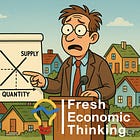I believe our public conversations about economics can be better
That's why I write FET
Next week, Part II of the Supply and Demand Series will be released for paid FET subscribers. Part I is here.
Dear readers,
Thank you for all your support, especially paid subscribers who keep this show on the road.
I have a difficult time balancing my desire to contribute to the public debate and my desire to provide valuable insights to paid subscribers.
One way to balance out those desires is to release high-value articles from behind the paywall after some time has passed, providing a headstart to paid supporters while still contributing to the broader public debate.
After my week of events in Sydney, I realised that many of the topics I write about are discussed around isolated policy campfires. Each little tribe at their campfire sees one side of an issue quite well, but their larger blind spots don’t get illuminated.
For example, removing stamp duty (a tax on property trades) comes up repeatedly as a clear policy win in some tribes. But many parts of the economic story are overlooked, such as the extra turnover of rental properties and forced tenant moves, the failure of no stamp duty in New Zealand to move the dial, and the fact that we don’t know if higher turnover of property concentrates ownership or broadens it (more here). These are just pure economic considerations. The politics are even trickier if we want to replace stamp duty revenue. Getting views from outside the tribe matters to fully understand the economics of even one simple policy question.
To help share insights that might get people talking across tribes, I have removed the paywall from several articles from last year. I discuss them below with a quick explanation of why they matter to the public conversation.
Housing supply filtering
The concept of filtering attracts a lot of interest. Filtering is thought by one tribe to indicate the importance of housing supply in any location or quality, as the people who move to a new home free up space where they were.
But the claims made that rely on filtering are very strange and confused. I try to clarify in this article and redirect us back to the main economic and policy questions at play when it comes to planning regulations and housing supply.
Density is not supply
Many claims are made that limits on housing density (dwellings per area) in some areas also limit housing production (dwellings per period of time) across all areas. This article clarifies how different dimensions are being erroneously conflated in such analysis, and that a coherent economic assessment must be clear about which dimension of housing is being affected by policy choices.
Superannuation is a bad retirement policy
One topic that came up at last Monday’s Big Dialogue panel on the Cost of Living Crisis was superannuation. The panellists noted that it is the younger households having a hard time right now, not older ones, so the recent policy change to increase the amount of wages contributed to compulsory retirement accounts (from 9.5% in FY2021 to 12% in FY2026) was a backward step.
I have explained many times why the superannuation system fails, and following the analysis to its logical conclusion, have noted that we would be better off without the superannuation system entirely and called for the system to be scrapped. These articles explain.
A couple of weeks ago, I appeared on SBS Insights to discuss these issues. You can watch that episode here.
Does planning make homes expensive?
At one campfire, there is much deference to Ed Glaeser on questions of planning policy and housing. Sure, incorporate some of Glaeser’s ideas into your worldview. But be very clear about the confused economics behind some of those ideas.
I explain in this article some of the bizarre economic reasoning of Harvard Professor Ed Glaeser on what the price of homes would be in the absence of planning regulations on the location and density of homes.
Also, don’t forget that everyone is a NIMBY at least once in their life. Which is fine. It is good that people care about their neighbourhoods and want to protect them from detrimental changes. Planning can be a useful tool to negotiate competing interests.
Energy policy
The United States “Abundance” trend is catching on in Australia, despite our very different political environment. Abundance-types want governments to get out of the way with pesky planning regimes when it comes to wind, solar and energy transmission infrastructure.
This is weird because the more important question is whether this type of electricity generation and distribution system is more efficient, and hence “abundant”, than a traditional baseload-dominated system.
Energy is a tricky topic. Mostly, we go with our gut. Hence, I removed the paywall from this article to show how reason and evidence led me to change my mind about whether nuclear power is a desirable generation technology.
Also, here’s a previous FET podcast on why the renewables grid is not going to be cheap or abundant because of the pure physics and engineering involved in handling intermittent and uncertain generation at dispersed locations.
Household cost of living
Finally, the cost of living was a recurring topic in last week’s events. One idea that comes up in certain tribes from time to time is the rise of dual-income families. Has this caused higher home prices and the feeling of being financially squeezed?
I document the historical patterns of dual-income families in this article to provide a much better context about when and how much change has occurred.
As always, please like, share, comment, and subscribe. Thanks for your support. You can find Fresh Economic Thinking on YouTube, Spotify, and Apple Podcasts.
Interested in learning more? Fresh Economic Thinking runs in-person and online workshops to help your organisation dig into the economic issues you face and learn powerful insights.













Exciting News: Groundbreaking Environmentally Friendly Power Station
Message to Cameron
I wanted to share some exciting news—our team has developed a revolutionary new environmentally friendly 1.2 gigawatt power station. This innovative technology is so advanced that it effectively renders traditional wind farms obsolete. The new system generates clean energy more efficiently and reliably, representing a significant leap forward in sustainable power generation. I look forward to telling you more about its capabilities and the positive impact it will have on the future of renewable energy.
David Angell Paulo
AUSTS Power Plants PTY LTD.
davidangellpaulo@austsecology.com